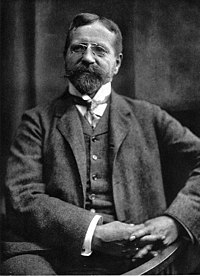
Hugo Vogel (15 February 1855, Magdeburg - 26 September 1934, Berlin) was a German painter, known primarily for historical scenes and portraits.
Life
[edit]His father was a merchant. After graduating from the Realschule in Magdeburg in 1874, he entered the Kunstakademie Düsseldorf, where he studied with Wilhelm Sohn and Eduard von Gebhardt among others.[1] He completed his courses there in 1880 and, three years later, exhibited several historical paintings at the Prussian Academy of Arts.

In 1886, following an extended visit to Italy, he settled in Berlin. The following year, he was given a professorship at the Academy,[1] a position he held until 1892, when he lost it as a result of the "Munch Affair". This involved an exhibit by the Norwegian artist Edvard Munch that was closed by the Academy's conservative Director, Anton von Werner. In protest, Vogel and several other painters joined together to create the "Vereinigung der XI", a precursor to the Berlin Secession. Among his notable students during his tenure were August von Brandis and Clara Siewert.
In 1893, he went to Paris to study with Jules Lefebvre. After that, he travelled throughout Spain, North Africa, Italy and the Low Countries. In 1900, he was awarded a gold medal at the "Große Berliner Kunstausstellung", a prestigious art exhibition held from 1893 to 1969.
In addition to his canvases, he created frescoes with historical themes in several town halls; notably in Berlin, Hamburg and Merseburg.[1] In 1902, the fresco in Merseburg, Der deutsche Michael, became the subject of plagiarism accusations when the magazine, Der Kunstwart, pointed out its resemblance to an equestrian statue by Paul Dubois, depicting Joan of Arc.[citation needed]
From 1915 to 1917, during World War I, he accompanied Paul von Hindenburg to the Eastern Front as his official portrait painter.[1]

He is buried at Wannsee Cemetery. Streets in Magdeburg and Berlin have been named in his honor.
References
[edit]- ^ a b c d Biographical notes @ AskArt.
Further reading
[edit]- Hugo Vogel, Als ich Hindenburg malte (When I Painted Hindenburg), Ullstein Verlag, 1927
- Sabine Liebscher. In the Magdeburger Biographisches Lexikon, Magdeburg 2002, ISBN 3-933046-49-1
Well, that’s interesting to know that Psilotum nudum are known as whisk ferns. Psilotum nudum is the commoner species of the two. While the P. flaccidum is a rare species and is found in the tropical islands. Both the species are usually epiphytic in habit and grow upon tree ferns. These species may also be terrestrial and grow in humus or in the crevices of the rocks.
View the detailed Guide of Psilotum nudum: Detailed Study Of Psilotum Nudum (Whisk Fern), Classification, Anatomy, Reproduction